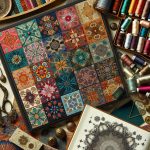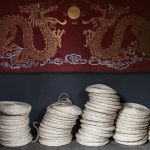Imagine a tapestry woven with threads of innovation and tradition—that's what renowned fabric designers have crafted over centuries. You can trace this intricate pattern from the historic works of William Morris to the contemporary creations of sustainable design leaders. Each designer is a unique thread, contributing to a larger, ever-evolving fabric of creativity and technological advancement. Curious about how these pioneers have shaped the textile industry and influenced modern aesthetics? Let's explore the stories and contributions of these visionaries who have redefined the art of fabric design.
Table of Contents
Key Takeaways
- William Morris was a champion of the Arts and Crafts movement, significantly influencing fabric design.
- Philippe de Lasalle revolutionized silk weaving techniques, leaving a lasting impact on textile craftsmanship.
- Lucienne Day's abstract patterns brought dynamic energy to post-war British textiles, blending art with utility.
- Marimekko redefined textile interaction with bold, vivid designs that resonate globally.
- Contemporary designers employ digital printing and 3D knitting to fuse traditional motifs with modern aesthetics.
Historic Pioneers
When you explore the history of fabric design, you'll discover that the innovations of early pioneers laid the groundwork for today's textile industry. These textile revolutionaries, often forgotten trailblazers, pushed the boundaries of what was possible with fabric, creating both functional and aesthetically pleasing designs.
Many of these unsung heroes were ahead of their time, marrying art and technology in ways that continue to influence modern designers.
Take, for example, William Morris, a design pioneer from the 19th century. Morris championed the Arts and Crafts movement, emphasizing handcrafted over mass-produced items. His intricate patterns and natural motifs remain timeless, inspiring contemporary designs.
Similarly, the French designer, Philippe de Lasalle, revolutionized silk weaving in the 18th century. His innovations included intricate brocade patterns that weren't only beautiful but also technically advanced for the time.
These historic pioneers didn't just create beautiful fabrics; they redefined what fabric design could be. By studying their techniques and philosophies, you'll gain invaluable insights into the foundational principles that guide modern textile creation.
Their legacy isn't just in the fabrics they produced but in the enduring influence they've on today's textile industry.
Mid-20th Century Innovators
The mid-20th century witnessed a wave of innovation in fabric design, driven by visionary artists who transformed textiles into bold, expressive art forms. Textile revolutionaries like Lucienne Day and Marimekko revolutionized the industry with their groundbreaking approaches to pattern and color.
You'd find their creative process reflective of their desire to break away from traditional designs, embracing modern influences that spoke to the changing times. Day's work, characterized by abstract patterns and vibrant hues, brought a fresh, dynamic energy to post-war Britain. Her designs, rooted in modernism, showcased how textiles could be both functional and artistically significant.
Marimekko, with its bold prints and inventive use of color, exemplified a fearless approach to fabric design. Their work didn't just adorn homes; it redefined how people interacted with everyday objects, making the ordinary extraordinary. These innovators weren't content with the status quo. They pushed boundaries, blending art with utility, resulting in timeless designs that still resonate today.
Contemporary Visionaries
In today's fabric design world, contemporary visionaries blend technological advancements with artistic creativity to craft innovative and sustainable textiles. You'll find designers who employ experimental techniques that push the boundaries of traditional fabric design. These visionaries leverage digital printing, 3D knitting, and smart textiles to create materials that aren't only visually striking but also highly functional.
Bold aesthetics characterize their work, where vivid colors and striking patterns come to life through cutting-edge methods. You can see how these designers transform fabrics into canvases, making each piece a statement of modern art.
Their designs are often a fusion of cross-cultural influences, seamlessly integrating traditional motifs with modern interpretations. This creates a rich tapestry that resonates with a global audience.
Sustainable Design Leaders
Many contemporary visionaries are also at the forefront of sustainable design, championing eco-friendly practices and materials. You'll find these leaders transforming the fabric industry by prioritizing sustainability from the ground up. They're making conscious choices to use eco-friendly materials, such as organic cotton, bamboo, and recycled polyester, which greatly reduce environmental impact.
These designers aren't just stopping at material choices; they're embracing circular economy practices to guarantee their creations have minimal waste and maximum lifecycle. By designing with the end in mind, they're facilitating garment recycling and upcycling, thereby ensuring that fabrics don't end up in landfills. This commitment to circularity is revolutionizing how you think about fabric longevity and waste reduction.
You'll notice that sustainability leaders are also engaging in transparent supply chains and ethical labor practices. They're partnering with fair-trade organizations and local artisans, guaranteeing every step of the production process aligns with their eco-conscious values. This holistic approach not only enhances the quality of the fabrics but also fosters a more just and equitable industry.
Technological Trailblazers
Pioneering fabric designers are harnessing cutting-edge technology to craft innovative textiles that push the boundaries of what's possible. As a connoisseur of fabric design, you'll be fascinated by how virtual reality and 3D printing are revolutionizing the industry.
With virtual reality, designers can now visualize and manipulate textile patterns in a 3D space before a single thread is woven. This immersive technology allows you to experiment with intricate designs and colors, ensuring your fabric is perfected before it even reaches the loom.
3D printing, on the other hand, brings a tactile dimension to textile innovation. Imagine creating complex, multi-layered fabrics with precision and speed previously unimaginable. This technology also enables you to produce custom textures and structures that would be impossible with traditional methods.
| Technology | Benefits | Applications |
|---|---|---|
| Virtual Reality | Enhanced visualization | Design simulations |
| 3D Printing | Precision and customization | Complex textures and structures |
| Digital Tools | Efficiency and innovation | Pattern creation and adjustments |
Frequently Asked Questions
What Are the Most Popular Fabric Design Schools?
You might think top fabric design schools aren't essential, but they are! Parsons and RISD are among the best, offering strong industry connections. Their programs give you the skills and network needed for success in fabric design.
How Do Fabric Designers Collaborate With Fashion Brands?
You collaborate with fashion brands through strategic brand partnerships, leveraging collaboration techniques such as co-designing collections, exclusive fabric creations, and joint marketing campaigns. This synergy enhances brand identity and elevates both your and the brand's market presence.
What Are Common Tools Used by Fabric Designers?
Like an artist with a versatile palette, you'll use digital software and traditional techniques. Tools like Adobe Illustrator, CAD programs, and hand-drawing skills help you create stunning fabric designs that set trends and inspire innovation.
How Can One Start a Career in Fabric Design?
To start a career in fabric design, you should master textile design techniques and seek design inspiration from various sources. Enroll in specialized courses, build a portfolio, and network with industry professionals to gain valuable insights and opportunities.
What Are the Latest Trends in Fabric Design?
Imagine vibrant fabrics that are both eco-friendly and intricately detailed. You're seeing the future of fabric design. Sustainable textiles and digital printing techniques are leading the latest trends, pushing boundaries and redefining what's possible in the industry.
- Tetron Fabric for Marine Applications: Durability and Use Cases - June 18, 2025
- Tetron Fabric for Outdoor Furniture: Weather Resistance and Care - June 18, 2025
- Tetron Fabric for Wall Coverings: Style and Application Tips - June 18, 2025







